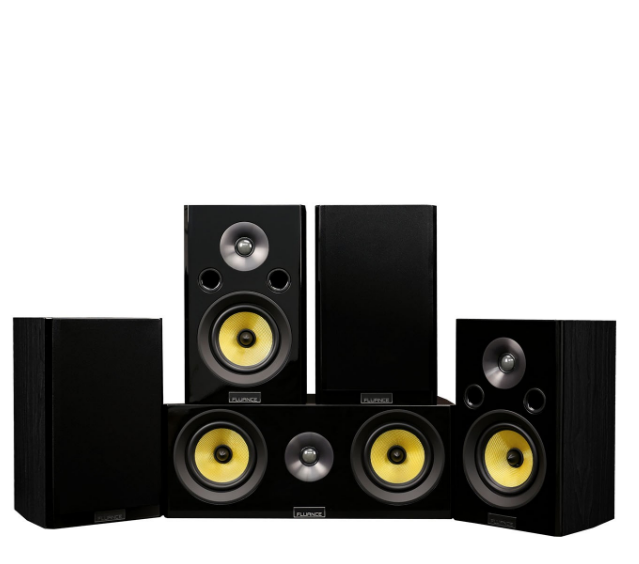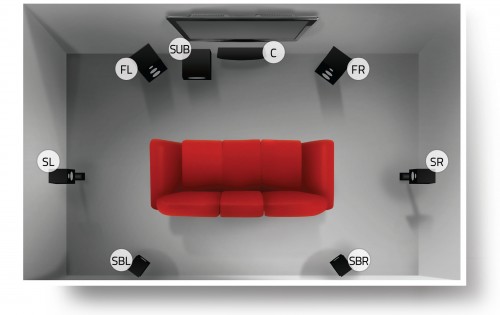Wiring the Right Way: Creating the Perfect 5.1 and 7.1 Setup
Sure, it’s great to throw down a bunch of cash for a nice complete home theater speaker system and the amp that makes it all work together, but this is only the beginning. Although many people take wiring for granted or consider it only as a necessary afterthought, the way people hook things up makes every difference in how their home theater systems ultimately sound.

Signature Series Hi-Fi 5.0 Home Theater Speaker System With Bookshelf Speakers
With a focus on sound excellence, every detail has been measured, tested, and perfected to recreate even the finest audio details with crystal clear accuracy.
Learn MoreHere are some tips on creating professional-worthy audio hookups at home.
Wiring Essentials
Surround speaker wires permits acoustic signals to pass from amplifiers to loudspeakers in a standard home theater setup. While this is relatively straightforward, specific properties of the wire in question impact various sound quality factors, such as noise, fidelity and attenuation, or signal reduction.
While the majority of speaker wiring conductors are formed from stranded copper wire or some similarly low-resistance alternative, no conductor is ideal; all metals have some resistance per unit length and cross-sectional area.
The resistance of a given conductor is directly related to how much energy loss a transmitted signal will experience when traveling through it.
In brief, longer, thinner cables generally cause more attenuation.
If a particular 5.1 home theater setup or design isn’t going to work because the speakers are too far away, it’s always possible to choose a thicker wire that can support transmission at a longer distance without fouling up the signal.
Remember however, that the AWG (American Wire Gauge) and SWG (Standard Wire Gauge) gauge numbers found on most speaker wires get smaller as wires get thicker.
12-18 gauge wire is recommended for all Fluance home theater speaker setups.
Resistance isn’t the only factor of concern when matching wiring to a home theater setup. Most modern speaker wire is manufactured in pairs; each length of cable contains two conductors that connect the positive and negative input terminals on a speaker to a corresponding pair on an amplifier.
These cables are separated by insulation that prevents signal crossover from one path to its partner. Unfortunately, this arrangement also forms a capacitor that adds to the wire’s frequency-based impedance, or reactance. Also contributing to reactance is the fact that audio signals include alternating currents that are naturally attenuated by a wire’s inductance, another form of frequency-based impedance.
Choosing the Appropriate Wiring Hardware
Does this sound like a lot of factors to keep track of? Fortunately, most speaker wire manufacturers publish detailed statistics about their products, and the majority of home theater components are close enough to one another that short variances don’t make an audible difference in signal strength.
Home theater amplifiers are generally rated to drive specific resistive load sizes, denoted in ohms (Ω). In addition to ensuring that the speaker’s load rating matches the amount specified by the amplifier, many audiophiles try to choose wires whose total resistance is less than 5 percent of the same number. For instance, a 5.1 home theater setup featuring a speaker with a 8Ω rating should be connected using a wire whose resistance is beneath 0.4Ω.
Some audiophiles also recommend that cables should never be longer than 15 m (50 ft.) in a standard home theater setup. While this limit depends on the dynamics of the space in question, longer wires often tend to act as radio antennas that can pick up random interference.
Electromagnetic interference is exacerbated even further when long stretches of wire are coiled up. Resist the temptation to simply make loops to get excess wire out of the way; instead, measure the distances between home theater components as accurately as possible, and cut or purchase wire to match precisely.
Ideal Home Theater Wiring Arrangements
There are other important factors to consider when creating a home theater setup. For one, speaker wire isn’t designed for high-stress situations; if it becomes snagged on something like a passerby or a pet and stretched forcefully, it might not immediately break, but such interactions can cause tiny tears in the internal wire strands that ultimately reduce sound quality.
Similarly, crushing forces on speaker wires may break conduction paths and impact the sound of a particular 5.1 home theater setup.
To be safe, always route speaker wires along safe paths, like walls and ceilings.
Use secure hooks, ties and cable management systems to keep wiring out of the way, and ensure that passive stresses, like the weight of the wire itself, don’t pull at connector terminals on amps and speakers.
Performing Customizations
In some cases, it may be necessary to cut wire sections to match a particular home theater setup. With classic paired wire, this is relatively straightforward because such cables lack outer sheathes; the bare stripped end of a cable can be inserted right into a terminal. Modern 5.1 home theater setups, on the other hand, often feature special connectors.
When creating a custom-length cable that incorporates a connector, always use a proper crimp tool to attach said connector to a freshly cut end. This simple step ensures that connections are physically stable enough to resist pops and static induced by inconsistent contact surfaces or random motion. Crimping also limits the amount of atmospheric exposure that bare wires experience, reducing the oxidization that could increase signal attenuation.

Top Surround Sound Tips
Consider all the previous tips when wiring a 7.1 or 5.1 home theater setup, but remember that these systems are a bit more complicated than the usual fare. In order to reproduce frequencies within designated ranges, surround sound components usually feature specialized characteristics. It may be prudent or necessary to choose different kinds of wire for individual speakers.
When routing multiple sections of wire along the same run or path becomes unavoidable, it can be helpful to work with shielded cables. Antenna interference effects are especially prominent at close range, and one signal path may cause crossover distortion or nasty feedback in another at close proximity. Also, try not to twist speaker wires together.
Finally, don’t be fooled into buying high-end cables just because they sport a cool look or a high-profile brand name. In many cases, simple, flat cables are more than sufficient for a 5.1 home theater setup.

100' 12 Gauge High Flex Precision Audio Cable Ultra Speaker Wire
The installation-friendly, non-gripping wire jacket is flexible yet rugged. Recommended for connecting any speaker to a very powerful amp. Get every ounce of juice from your amplifier to your speakers with this oxygen free copper wire.
Learn More
I’m pretty pleased to discover this web site. I need to to thank you for ones time due to this fantastic read!!
I definitely really liked every little bit of it and i also have you book marked to see new stuff in your web site.
Thanks for mentioning that speaker wire permits acoustic signals to pass from amplifiers to loudspeakers in a home setup. You also said that wire that has no conductors are ideal. I think it’s a good idea to do a dry-run before you install so that you can see any roadblocks that you might come up to beforehand.
Great to hear. Glad to hear you enjoyed it.
Yes indeed. You wouldn’t want to go to all the effort of setting up all your wiring without testing to ensure everything is going through properly.